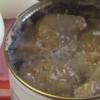Iodine in the human body. What foods contain iodine? Foods rich in iodine
Everyone has long known that the presence of certain chemical elements is necessary for the normal functioning of the body. In large quantities, chemicals can cause significant harm to humans, but in very small doses, their benefits are invaluable.
This mainly concerns the glands that regulate through hormones. One of these essential elements is iodine.
Let's take a closer look at what a lack or excess of this trace element in the body can lead to, what foods contain iodine. Let's talk about everything in a simple and accessible language, without delving into medical terminology.
Surely many of our readers asked the question, what is iodine and what is its role in the body?
Note!
It is important to know that iodine is not only a drug sold in a pharmacy for disinfecting and treating cuts or wounds, but also an essential trace element for the functioning of the human body, without which we cannot do. It is he who is responsible for the normal functioning and functioning of the thyroid gland, which produces hormones vital for us. A healthy and properly functioning thyroid gland is a guarantee that a person will not have problems with the heart, liver and metabolic processes.
Regular intake of iodine in the body increases the absorption of oxygen by tissues, improves mental activity. A person becomes more alert, more energetic, less tired. This microelement has a positive effect on the condition of hair, teeth and skin.
Iodine as a chemical element

Iodine was first identified and discovered in 1811 by the French chemist Bernard Courtois. When the seaweed ash was heated, purple steam began to be released. It is because of the color that they began to call it iodine, which in Greek means: purple.
In nature, this type of chemical appears in the form of black crystals with a gray tint and a metallic sheen. Extremely quickly forms pairs with a specific pungent odor.
In the famous periodic system of Mendeleev, it is in group 17 and is considered a halogen. Has found wide application in medicine. Iodine is a rather rare element, but it is very scattered in nature and can be found almost everywhere.
- in sea water in the form of iodides (25 mg per ton of sea water);
- in kelp algae (2.5g per ton of dry seaweed).
Up to 98% of all terrestrial iodine reserves are in Chile and Japan. There it is extracted from seaweed, sodium nitrate and other raw materials. In Russia, iodine is also extracted from oil drilling waters.
This rare mineral has found its application in many areas of human activity:
- Medicine - the use of alcohol and other solutions as an antiseptic helps to effectively destroy the harmful flora.
- Forensics is the detection of fingerprints on paper, such as banknotes.
- Technics.
- The light source is in halogen lamps, metal halide lamps.
- Battery manufacturing is the positive electrode component in lithium-iodine batteries.
- Laser thermonuclear synthesis.
- Radioelectronic industry.

As already mentioned, iodine is a microelement and is found in animal tissues and in many plants. How much iodine in plants depends on its content in the soil. Certain types of seaweed, namely kelp, fucus accumulate more than 1% of iodine.
In the human body, the iodine molecule is part of the thyroid hormones that are produced by the thyroid gland. The role of the thyroid gland is very difficult to overestimate. Thyroxine and triiodothyranine affect metabolism, growth and development of the body.
The daily requirement depends on the condition, age of the body. All biological effects due to the action of thyroid hormones can be divided into three groups:
- Anabolic action - influence on the growth and differentiation of tissues.
- Metabolic action - an increase in the intensity of energy production.
- Sensitizing effects - an increase in the sensitivity of cells to the action of other hormones, in particular estrogens and catecholamines.
Iodine, as a microelement, is an integral part of active thyroid hormone molecules. In the thyroid gland itself, thyroxin T4 is produced; it contains 4 iodine atoms.
This hormone does not have biological activity, but, getting into the peripheral tissues with the blood flow, it turns into the active hormone T3, respectively, with three iodine atoms. It is this hormone that affects almost all organs and tissues. The thyroid gland produces up to 110 mcg per day. T4.
Normal production of the hormone is possible only with sufficient intake of iodine from food. In cases of insufficient intake of a trace element, the body seeks to somehow compensate for its deficiency.
First of all, there is a structural restructuring of the gland itself and the central control of the thyroid gland, the central nervous system, namely the hypothalamus, changes. The thyroid gland evenly increases in size, or it occurs in the form of nodes. The consumption of available iodine by the body becomes more economical.

According to statistics from the World Health Organization, around the world, about 2 billion people, which is equal to a third of the world's population, are living in conditions of iodine deficiency. On the territory of the CIS countries, there are practically no regions with sufficient natural iodine content, both in soil and in water.
As a result, the inhabitants of these countries do not receive sufficient for a normal existence, the amount of iodine with food. Iodine deficiency is manifested most often by an increase in the thyroid gland - endemic goiter, a decrease in thyroid function - hypothyroidism. If children suffer from such a deficiency from birth, then this contributes to the development of mental retardation or cretinism.
Congenital hypothyroidism, and general developmental delay, both physical and mental. Iodine deficiency is extremely unfavorable for women of reproductive age. This leads to infertility, miscarriage or stillbirth. In rare cases, children with congenital deformities are born.

A person suffering from insufficient iodine intake may experience the following symptoms:
- Rapid fatigue is associated with a violation of energy production in every cell of the body.
- Decreased mood, prolonged depressive depressed mood.
- Decreased appetite - unwillingness to eat.
- Weight gain - despite a decrease in appetite, weight increases due to edema.
- Violation of the intestines, a tendency to constipation.
- Dryness of the skin - the skin becomes dull, thin, flaky or even covered with horny scales.
- Hair loss is a fairly global phenomenon and immediately becomes noticeable to the patient, the hair falls out in clumps, and the eyebrows from the side of the temples also thin out.
- Violation of the cardiovascular system - low blood pressure, shortness of breath, palpitations, heart rhythm disturbance.
- Memory impairment - this can be manifested in schoolchildren by a decrease in academic performance, absent-mindedness.
- Frequent colds - a decrease in immunity and the addition of various pathogenic viruses and bacterial infections.
- Violation of the synthesis of sex hormones - this is manifested by a violation of the menstrual cycle, possible infertility in women. Violation of potency in men.
- In severe cases, an increase in the thyroid gland, noticeable to the naked eye. In addition, an enlarged gland can compress the nerve plexuses of the neck. This is manifested by hoarseness of voice, dry causeless cough, difficulty swallowing.
Causes of iodine deficiency in the body
The global cause of iodine deficiency , as already mentioned, the natural uneven distribution of iodine in water and soil on the planet serves. Of course, you can solve this problem if you settle in the coastal zone. Residents of countries and regions that live on the shores of the seas and oceans very rarely suffer from iodine deficiency. But this solution is not for everyone.
In second place is malnutrition. Eating foods that contain iodine does not cover the daily requirement for it. This may affect people with a low social standard of living, serving in the army, prisoners, and others.
Problems with the gastrointestinal tract often contribute to impaired absorption and absorption of iodine. Some chemical trace elements also prevent useful iodine from being absorbed in the intestines - these are: bromine, manganese, calcium, chlorine, cobalt.
A heavily polluted environment or living near chemical plants, nuclear power plants and factories with harmful emissions can contribute to iodine deficiency. Taking medications is another important factor that provides iodine deficiency.
Who is at risk
Most of all, iodine is necessary for that category of people in whose body there is an active growth and development. Of course, these are women during pregnancy and lactation.
A small organism growing in a woman should not be deficient in thyroid hormones. Children, throughout growth and development, also need more iodine.

- Children under 1 year old - require 50 mcg / day.
- Children 2-7 years old - 92 mcg / day.
- Children 8–13 years old 120 mcg/day.
- Adolescents (12 years of age and older) and adults 150 mcg/day.
- Pregnant and breastfeeding 200 mcg/day.
- Elderly people 100 mcg/day.
Foods containing iodine

Fortunately, in stores we can find a sufficient number of high-quality products, thanks to which replenishing the daily requirement of iodine is not difficult.
As already mentioned, seaweed is the leader in the amount of iodine. Laminaria and fuchsia contain up to 200 micrograms per 100 grams of weight. Thus, by eating only 100 grams of seaweed, you can get the right amount of iodine.
Of course, one must take into account the specific taste and smell of seaweed and that not all people can eat it. In this case, manufacturers can please us with dry algae, which can be added to food as a seasoning.
Let us dwell in more detail on which foods contain a large amount of iodine.

This type of living beings is able to accumulate iodine in their tissues. In this regard, not only fish, but also seafood are especially useful. Here is a partial list of iodine content per 100 grams of body weight:
- cod liver - 350 mcg / 100 gr;
- tuna -145 mcg / 100 gr;
- shrimp -190 mcg / 100 gr;
- oysters - 60 mcg / 100 gr;
- salmon, flounder - 200 mcg / 100 gr;
- pink salmon, chum - 50 mcg / 100 gr.
Animal meat and dairy products

Meat and milk are also a source of iodine for the body. According to the content of the microelement, these products, of course, are inferior to fish, but they should not be neglected. Milk, in addition to iodine, can give your body calcium, protein, and many vitamins.
- pork meat - 17 mcg / 100 gr
- beef meat -12 mcg / 100 gr;
- milk - 20 mcg / 100 g;
- cheeses - 11 mcg / 100 gr;
- butter - 10 mcg / 100 gr.

With modern methods of growing plants, it is impossible to say with certainty that the iodine content in vegetables and fruits sold on the market meets some standards, but it is simply necessary to include these products in the diet.
- apples with pits - 70 mcg / 100 gr;
- persimmon - 30 mcg / 100 gr;
- feijoa - 70 mcg / 100 g;
- beets - 7 mcg / 100 g;
- potatoes - 7 mcg / 100 gr;
- carrots - 5 mcg / 100 g;
- sorrel - 3 mcg / 100 gr.
This is not the whole list of products that contain iodine. , this also includes red caviar, buckwheat, and other types of seafood.
Foods high in iodine
Iodine deficiency leads to depression, loss of strength, weight gain and poor brain function. So that we can avoid all these health problems, it is important to properly structure our diet and know which foods are high in iodine. Let's take a closer look at the list of foods rich in iodine.

We already know that iodine plays a major role in the normal functioning of the thyroid gland, and the better it works, the higher the metabolic rate in the body. Also, iodine contributes to the efficient burning of calories: turning them into necessary energy, and not into harmful fat.
An irreplaceable trace element strengthens hair roots, preventing hair loss, improves immunity, and reduces the risk of cancer.
These conclusions were made by the World Health Organization on the basis of data from world studies.
- It is known that the required daily intake of iodine is 150 mcg.
- And for pregnant women - 250 mcg.
The norm of iodine that we need can be obtained even when living far from the sea, it is enough to include foods containing iodine in the diet, and they, for sure, can be found in the kitchen of every good housewife.

A small sour berry contains a huge amount of valuable vitamins, antioxidants, nutrients and trace elements, including vitamin K, which promotes good absorption of calcium, vitamin C, fiber and iodine.
100 grams of cranberries contain - 350 micrograms of iodine.

This sweet red berry contains quite a lot of iodine:
one cup of strawberries contains approximately 13 micrograms, which is about 10% of the daily requirement of iodine.
Strawberries also regulate blood pressure, strengthen the immune system, and thanks to vitamin C, reduce "bad cholesterol" in the blood.
Prunes
These dried fruits have many important and beneficial properties for our health: regulates blood sugar, which reduces the risk of obesity and type 2 diabetes, prevents cancer, strengthens bones, lowers cholesterol.
Only 5 pieces of prunes contain - 13 micrograms of iodine.
Prunes also contain vitamin K and beta-carotene. Eating foods containing beta carotene makes people happier and improves mood, according to a study by The Harvard School of Public Health in 2013.

Almost all seafood contains a lot of iodine, however, among all marine life, shrimp occupy a special place.
100 grams of these crustaceans contain - 40 micrograms of iodine.
Cod
This white fish is low in calories and fat, but it is rich in vitamins and beneficial trace elements, including iodine.
A serving of 100 grams of cod contains - 110 micrograms of iodine.
There is a lot of calcium in cod, it is also rich in phosphorus, potassium, magnesium, B vitamins, vitamin E, it is especially worth highlighting vitamin B12, which is good for the heart and takes an active part in the work of the heart and blood vessels.

Although tuna fish is more oily than cod, it is also very healthy. A special valuable property of tuna is its ability to prevent such a formidable disease as a stroke.
100 grams of tuna contains about 18 micrograms of iodine.
Also in this fish a lot of iron, magnesium, calcium, phosphorus and vitamins.
Recent studies have confirmed that people who eat tuna 4-5 times a week have a 30% lower risk of stroke.
Turkey

Everyone loves turkey meat: both those who lose weight for a small percentage of fat and athletes for their high protein content. But turkey is also worth loving because it is a healthy source of iodine.
100 grams of turkey meat contains about 37 micrograms of iodine.
Also, the meat of this bird has a high concentration of other useful substances: iron, phosphorus, potassium, zinc, calcium and vitamins. Prepare a delicious turkey dish and saturate your body with everything you need for health.
Potato

Many people are critical of eating potatoes, because they are high in starch, and this can add extra weight. But sometimes you can and even need to eat potatoes.
It contains: iron, zinc, phosphorus, calcium - these trace elements help strengthen bones, Vitamin B6 prevents nervous disorders, helps to digest proteins and fats, as well as potassium and magnesium.
One medium-sized potato contains - 60 micrograms of iodine, which is half the daily intake of this trace element.
It is better to eat potatoes baked than to mash them with butter or full-fat milk.
Beans
Dishes made from beans are rich in iodine and tasty, and they are also very healthy: beans contain a lot of fiber, have a low glycemic index, which is important for people with diabetes. After all, it is known that the level of GI contributes to a decrease or increase in blood sugar.
100 grams of beans contain - 30 micrograms of iodine.
In addition, beans are rich in magnesium, zinc, copper, folic acid, which is needed to create new cells and keep them healthy.
sea kale

These algae are a real leader in iodine content, along with cranberries.
It is important to know that 100 grams of seaweed contain approximately 300 micrograms of iodine, which is 2 times more than the daily norm!
Also, sea kale is rich in vitamins, microelements and very low-calorie, only 25 calories per 100 grams and there are almost no carbohydrates and fats in it - it is just a godsend for losing weight people. It is from seaweed that the famous nori sheets are made, for twisting rolls.

There are three options for preventing iodine deficiency:
- mass;
- group;
- individual.
From the point of view of economic benefits and efficiency, mass prevention comes first. Its essence is to add iodine salts (iodates) to the most consumed food product. Thus, the most versatile method is iodization of common table salt.
Salt is consumed by all segments of the population, regardless of income level and social status. The only drawback may be the unusual smell of iodine and a possible aftertaste. A standard is used according to which 4 mg is added for each kilogram of table salt. potassium iodate.
With an average salt intake of 7 to 10 g/day, taking into account 50% loss of iodine during storage and cooking, this level provides the human body with 150 micrograms of iodine per day.
For the best effect, salt must be used correctly. It must be stored in sealed packaging for no more than 4 months. It is advisable to salt already prepared dishes to prevent the evaporation of iodine.
excess iodine

In the case when a person consumes iodine-rich foods in combination with drugs that compensate for the lack of iodine, a state of excess iodine may occur. As you know, an excess, just like a lack of trace elements, can have an extremely negative impact on health.
Fortunately, there is little chance of encountering such a situation in reality, because iodine is quickly excreted from the body.
Symptoms of an excess of iodine:
- weakness;
- recurrent headaches;
- metallic taste in the mouth;
- hyperthermia;
- disruption of the heart.
Myths and truth about iodine

At the end of our conversation, we will discuss with you important and frequently asked questions by many people regarding iodine:
Around the problem of iodine deficiency there are many different opinions of people. Sometimes people tend to solve the problem of the lack of this trace element in an unconventional way.
Is it true that iodine deficiency in the body can be determined at home by applying an iodine grid?
Iodine deficiency and iodine mesh. There is an opinion that if you apply a mesh of an alcoholic solution of iodine to the skin and it becomes dull, this is a sure sign of iodine deficiency. Of course, this is not the case, no skin tests can determine the level of any trace element in the body. It is possible to establish a deficiency of any microelement in the body only with the help of laboratory analysis (for iodine content, urine is taken for analysis).
Is it true that if you drink a drop of an alcoholic solution of iodine, you can fill the daily requirement?
Don't do this under any circumstances! This is not only a false statement, but also quite dangerous. And not because this drop contains 30 times more iodine than a person needs per day. The fact is that an alcohol solution can cause burns of the mucous membrane of the oropharynx and esophagus and the thyroid gland will be seriously affected.

Do I need to take, in addition, tablets that contain iodine?
Such drugs should be taken only according to the testimony of a doctor! It is important to eat a healthy and balanced diet. Include in your diet both foods containing iodine and foods rich in other important micronutrients, and this will be enough for the well-being and health of most of us.
Is it true that lack of iodine adversely affects the overall health and body?
Yes, this is true. The fact is that with a regular lack of iodine, a person begins to experience a lack of strength, to notice that he gets tired very quickly, feels overwhelmed and completely exhausted. Usually this condition is written off as a general banal malaise. And everything is much more serious and these are the first signs that the body is experiencing an iodine deficiency.
Conclusion

For the smooth operation of the endocrine system, we urgently need such an element as iodine. The lack of this element negatively affects the work of the whole organism and significantly affects the well-being of a person.
Knowing which foods contain iodine, you can include them in your diet and solve the problem of iodine deficiency. A balanced diet will help avoid many thyroid problems.
The normal functioning of the human body depends on a sufficient amount of essential trace elements. One of the most important is iodine. It is involved in the growth and development of the child, is responsible for the hormonal balance in the body and the normal functioning of all organs. But the difficulty is that it is not synthesized by the body. And you need to ensure a daily intake of at least 100-150 mg of iodine with food. When nutrition is balanced, this problem does not arise. But a modern person often uses products of poor quality and poor in trace elements. Therefore, you need to know what contains iodine in large quantities, so as not to experience a lack of it. If you regularly include such foods in your diet, many health problems can be avoided.
Why does the body need iodine?
It is one of the most essential trace elements for the healthy functioning of all body cells. Iodine performs the following functions:
this trace element
Few people think about what contains iodine. After all, it is not always possible to associate malaise and health disorders with its lack. Many symptoms that could be eliminated by simply increasing the amount of iodine in the diet are mistaken for manifestations of other diseases. Therefore, it is best to consult an endocrinologist in the presence of such pathologies:

How to make up for the lack of iodine
In the body, this microelement is not produced and does not accumulate. Therefore, daily replenishment from the outside is necessary. According to statistics, now one sixth of all mankind is deficient in iodine. This is especially dangerous for children. A tenth of all the necessary iodine a person receives from air and water, the rest must come from food. And you need to know what iodine contains in order to prevent malfunctions in the body.
But the problem is also that during the heat treatment of products, most trace elements are destroyed. A certain amount of iodine is also lost. This also leads to its lack in the body. Therefore, products that contain iodine, it is desirable to use fresh. They can also be stewed or baked with as little heat as possible.
Before figuring out what you need to eat to make up for the lack of iodine, it is important to understand how much of it should come from food. For each person, the norm is individual. For example, babies need 50 to 90 micrograms, schoolchildren need 120 micrograms, and adolescents and adults need 150 micrograms per day. In some cases, for example, during pregnancy, while breastfeeding or with thyroid diseases, the dose of iodine should be increased to 200 mcg.

What foods contain the most iodine?
In order for a sufficient amount of this microelement to enter the body with food, it is necessary to balance your diet. You need to find out your iodine rate, which is necessary for the normal functioning of the thyroid gland and other organs; it is different for each person. Therefore, it is impossible to say exactly how much and what you need to eat in order to make up for the lack of this substance. But with symptoms of its lack, it is necessary to include in the diet the foods richest in it. The largest amount of iodine is found in such products:

Iodine in seafood
Such food best compensates for the lack of this trace element. All marine life accumulate iodine directly from the water. And it is known that most of all it is in the ocean. Various seafood contains a large amount of iodine. For example, only 100-150 g of sea kale can replenish its daily intake. In addition, it is desirable to include sea fish in the diet more often - salmon, tuna, halibut, cod, flounder. It needs a little more, since half of the iodine is lost during heat treatment. Do not forget about such seafood as mussels, shrimps, squids, oysters, crabs. They are considered delicacies, but among other things, they are also very useful.

Dairy products containing iodine
But not only seafood can make up for the lack of this trace element. A glass of fresh whole milk contains 30-40% of the daily requirement of iodine. There is also a lot of it in cream, condensed milk, cheeses, especially processed ones, cottage cheese and kefir. Therefore, dairy products not only provide the body with enough calcium and vitamin D. If they are less cooked, they can make up for the lack of iodine. It is especially important to include dairy products in the diet of children and adolescents, as well as pregnant women.

Iodine in plant foods
In small quantities, this microelement is also found in what grows. Especially if vegetables and fruits are grown in regions near the sea. Where is iodine found in the highest quantities? Most of all, it accumulates in greens, especially parsley, dill and spinach, bell peppers, garlic, broccoli. Lots of iodine in baked potatoes, carrots and cabbage. From fruits, you need to pay attention to persimmons, grapes, peaches, plums and cranberries. A lot of iodine is also in such an exotic fruit as feijoa. If vegetables and fruits are grown on lands rich in this trace element, just a kilogram of fresh fruit per day will make up for its deficiency.
What else contains iodine? Do not forget also about such necessary products on our table as cereals. A lot of iodine in buckwheat, oatmeal, wheat bran, whole grain bread. You should try to heat them as little as possible.

How else to make up for the lack of iodine
First of all, you should pay attention to the water. Even ordinary water contains iodine. Drinking at least 2 liters per day, you can get about 30 mg of this trace element. In addition, people living near the sea get iodine by inhaling it with air. All local vegetables and fruits there are enriched with this trace element. And in regions where there is very little iodine in the soil, it is added to many products. Most often - in salt. But it is worth remembering that during long-term storage, as well as during heat treatment, the iodine content decreases. In regions where soils are poor in this trace element, it is added to mineral water, juices, dairy products and bread.
In pharmacies, you can also purchase dietary supplements and vitamin-mineral complexes to compensate for iodine deficiency. But before using them, you should consult your doctor. To compensate for iodine deficiency, you can use "Iodine-Active", "Iodomarin", "Iodine-Balance", and others. But it is worth remembering that this trace element is absorbed from them worse than from products. In addition, some substances slow down the absorption of iodine. Therefore, you need to consume less products and drugs containing bromine, iron, manganese, calcium, cobalt, lithium.

Iodine overdose
An excess of this trace element is no less dangerous than a deficiency. Therefore, before finding out where iodine is contained, in which products it is the most, it is necessary to consult a doctor. After all, with some diseases of the thyroid gland, additional intake of it into the body can be dangerous. The fact that an overdose of iodine has occurred can be understood by the following symptoms:
- disruption of the thyroid gland;
- a sharp decrease in weight, emaciation;
- weakness, muscle atrophy, sweating, hand tremors;
- early appearance of gray hair;
- irritability, tearfulness, insomnia;
- allergic reactions;
- diarrhea, disruption of the stomach and intestines.
It is very important to pay attention to the diet. If it is varied and balanced, many health problems can be avoided.
Iodine plays an essential role in the human body. In the table of D. I. Mendeleev, he stands at number 53. Its biological component is very strong.
The role of iodine in the human body
This element is involved in the formation of the most important thyroid hormones for humans, which are responsible for proper growth and development, for the metabolic processes involved in the functioning of our body. The chemical trace element iodine in the human body is required in a strictly defined amount for the proper development and functioning of the thyroid gland. You can get the necessary portion of this element only from the outside. Therefore, it is important to know what food is rich in them.
The emergence of iodine
Iodine was first discovered in 1811 by B. Courtois, a French chemist. He began heating seaweed with sulfuric acid, thus creating a new element in the periodic table. Iodine, as a chemical element, is the rarest on the planet. Its share is 4*10 -5%. Despite this, it is found everywhere. Especially a lot of it in the seas, in the waters of the ocean, in the air of coastal zones. The highest concentration of iodine is in seaweed.
Functions of iodine
Contributes to the normal functioning of the thyroid gland;
Participates in energy metabolism;
Affects the maintenance of optimal body temperature;
Responsible for fat and protein metabolism;
Necessary for the growth and development of the body;
Affects the stable state of the nervous system.
The role of iodine in the human body is difficult to overestimate. It affects the mental activity of the body, the healthy condition of the skin, teeth, hair, nails. It is extremely important for the healthy growth of children, helps to develop mental abilities. At the same time, the efficiency increases, excessive irritability decreases.
A child who received less iodine in the womb will have developmental deficiencies in various organs. In the future, such children often suffer from developmental delays and neuropsychiatric disorders. With the usual size of the thyroid gland and a slight change in hormones, it is very difficult to determine the disease of goiter. If symptoms such as headache, general malaise, chest pain, decreased emotional background occur, and this is not associated with another disease, then an endocrinologist should be examined.
lack of iodine
Iodine deficiency mainly affects those regions that live far from the maritime climate. In Russia, this is approximately 70% of the total area of the country. People need to self-monitor their intake of food containing iodine. Its value for the body is enormous. Therefore, it is very important to know which foods contain iodine. Especially pregnant women and children. If the body does not have enough of it, then a goiter grows, the gland becomes large.

Symptoms of iodine deficiency:
Infertility;
Risk of miscarriage;
Developmental delay of the child;
The risk of cancer of the gland;
Congenital pathologies.
Signs of iodine deficiency
- Endometrial goiter.
- Lack of performance.
- Rapid fatigue.
- Feeling irritable.
- Hypothyroidism.
To recognize whether iodine is present in sufficient quantities in the human body, a simple test will help. In the evening, moisten a cotton swab with an alcohol-containing solution, apply the strips to a small area of the body. In the morning, carefully consider the place on which the solution was applied. If you don’t find anything there, then, accordingly, you urgently need to replenish supplies by consuming food. Well, if iodine strips remain visible on the body, then you don’t need to use it additionally.

excess iodine
Iodine in the human body is involved in many processes. If a sufficient amount enters it, then the thyroid gland functions normally. But not only its lack is dangerous for the body, but also its overabundance.
Oversaturation in the body can occur due to its improper use, or rather the use of its inorganic type substitute. It is available in tablet form and as part of dietary supplements. Iodine in preparations is rather poorly absorbed by the body. For example, if you eat a lot of fish, seaweed, persimmons and other products containing trace elements in an organic form, then the body manages to absorb it in sufficient quantities, and the remains are excreted naturally.
Well, if you use iodine in medicines, then the body absorbs it completely. This can result in oversaturation. It manifests itself as a disease such as hypothyroidism. It is a disease caused by a deficiency or excess of thyroid hormones.
Also, an overdose can be received by a person directly involved in the extraction of this mineral. Symptoms of iodine poisoning:
Irritability of the respiratory tract;
Iododerma is a skin disease;
Salivation, lacrimation;
runny nose, sore throat;
Taste of iron in the mouth;
Nausea, vomiting;
Rapid fatigue, dizziness, tinnitus.
What foods contain iodine? An interesting fact is that most of them are under water. All kinds of freshwater fish, marine life, algae, shrimp and more. Most of the iodine people get from food. Foods rich in it can be of both animal and vegetable origin.
But there is another way to deliver it to the body. Through the air The content of iodine in foods is not comparable to its concentration in the air. The inhabitants of the coastal regions were very lucky with this. In sea air, it is found in large quantities.
Animal sources of iodine:
Fish - freshwater, marine;
Seafood - oysters, crabs, shrimps, sea kale;
Dairy products - butter, milk, cottage cheese, fermented baked milk;
Chicken eggs.

Plant sources of iodine:
Fruits - persimmons, apples, grapes;
Vegetables - lettuce, potatoes, tomatoes;
Berries - currants, cranberries;
Cereals - buckwheat, rye, wheat.

The use of iodine in medicine
This microelement has been popular in medicine since ancient times, although it is rarely used in concentrated form. This is an exceptional drug with increased biological activity and comprehensive action.
It is mainly used as various medicines and preparations. Iodine is an essential trace element for the natural functioning of the human body. In medicinal form, it is used as an antimicrobial, anti-inflammatory agent. It also has a disinfecting effect on skin diseases, cuts, wounds. It is used orally for atherosclerosis, thyroid disease.

Preparations containing:
Organic iodine - a solution of 5% or 10% alcohol;
Inorganic - "Potassium iodide", "Sodium iodide";
Substances that split - "Iodoform", "Iodinol";
X-ray contrast media.
kidney disease;
Pulmonary tuberculosis;
Individual intolerance to the drug.
What is iodine?
- An ordinary bottle of brown liquid, which can be found in almost every first aid kit?
- A substance with healing properties that bears the beautiful ancient Greek name "violet" given to it by the French chemist Bernard Courtois?
- Or a chemical element with atomic number 53?
Each option deserves primacy in the characterization of a given substance, revealing its properties from one side or another.

Chemists describe iodine as black/gray crystals with a characteristic purple sheen and a pungent odor. When they are heated, violet-colored vapors are released, thanks to which the element got its name.
INTERESTING! The discovery of the chemical dates back to the 18th century, although the well-known medical iodine solution began to be used much later.
 In the periodic table of Mendeleev, the element denoted as I (from Iodum), has the 53rd atomic number, refers to the active non-metals and the halogen group.
In the periodic table of Mendeleev, the element denoted as I (from Iodum), has the 53rd atomic number, refers to the active non-metals and the halogen group.
The chemical properties of the element are similar to Chlorine, except that it is extracted from seaweed/petroleum sources, resulting in characteristic crystals with a metallic sheen/pungent odor.
Also, the substance turned out to be volatile even at room temperature. With minimal heating, it may ignite and begin to evaporate. The pairs have a bright purple hue.
Being in nature
Iodine is quite dispersed in nature, due to which it is contained in almost all bodies of the planet. But in its pure form, it is almost impossible to detect it. Small deposits are found in Chile, Japan, but, in most cases, the substance has to be extracted from algae, saltpeter, waters of petroleum origin.
A significant concentration of the element is in sea water, chernozem, peat. The main "reservoir" of halogen is the World Ocean, from which halogen enters the atmosphere, to the continents. The territory remote from the ocean is rightly considered poor in this substance. The same goes for mountainous terrain. 
Chemical/Physical Properties
Iodine, as a chemical element, halogen, an inactive metal has several features:
- is a strong oxidizing agent;
- on its basis, a number of acids are formed;
- it is distinguished by a special reaction of the compound with starch in the form of a blue color;
- interacts with metals (as a result of which iodides appear);
- due to heating, it combines with hydrogen;
- vapors of the substance are poisonous (under their influence, the mucous membrane, which suffers first of all, is especially vulnerable).
Physical properties of halogen:
- the element consists of only one isotope (iodine-127);
- usually it is a crystalline substance of a solid consistency, dark in color, with a metallic sheen and a peculiar smell;
- iodine vapor is bright purple in color, formed even with a slight increase in temperature;
- when cooled, the halogen vapor immediately crystallizes, bypassing the liquid form;
- if you heat iodine with an additional source of pressure, you can get the liquid state of the microelement.
Iodine in the human body
 The beneficial properties of iodine are of particular importance for the entire human body, since the use of this substance in medical practice has long been justified.
The beneficial properties of iodine are of particular importance for the entire human body, since the use of this substance in medical practice has long been justified.
According to many sources, the element is especially necessary for the thyroid gland, because it is an indispensable component of its hormonal background.
It is in this part of the body that the concentration of the chemical element is more than 65%, the remaining 35% are concentrated in muscle tissues, blood, and ovaries. In micrograms, this at least 50 per day for a child's body, 120-150 for an adult, 190-210 for pregnant and lactating women.
At the same time, the influence of this substance on all life processes is really invaluable:
- iodine controls body heat regulation;
- promotes metabolism, metabolism, water-electrolyte processes;
- is responsible for the proper development of muscle tissue, the musculoskeletal system.
IMPORTANT! Do not forget about psychological / emotional health, the stability of which largely depends on the concentration of the trace element.
BUT! Organs and tissues cannot produce halogen on their own, therefore external sources of the element are so important for their full functioning: food, sea air, medicines.
Signs of iodine deficiency
Is ordinary iodine so important for human life? And
As practice shows, everything should be even. After all, the harm of iodine is not a fictional fact, since this
This refers to halogen poisoning, chronic or acute. In the first case, the body consistently receives a significant dose of a chemical, but this is not enough for a vivid clinical picture. So the first signs may appear years later.
The acute form of poisoning manifests itself immediately, causing disruption of the cardiovascular / respiratory systems. The patient's life is in danger, and health is in danger.
However, not every excess of iodine can be called poisoning. Most often, pathology manifests itself as a complex of symptoms.:
- Iododerma or skin lesions
- The patient (the area of the face, neck, arms, legs) develops a characteristic rash, somewhat reminiscent of acne. A distinctive factor is considered to be severe discomfort, burning, itching, as well as a kind of merging of several formations into one spot with a purple tint.
- Conjunctivitis. Mucous membranes are especially vulnerable to halogen, which manifests itself as inflammation, lacrimation, visual impairment.
- Respiratory diseases. Caused by irritation of the respiratory tract.
- Increased salivation. The salivary glands also suffer from an increased concentration of iodine in the body, swell / become inflamed.
- Additional symptoms
It is less common, but, nevertheless, it takes place: a metallic taste in the mouth, an unpleasant odor, discomfort in the mucous throat, malfunction of the gastrointestinal tract / genitourinary system, decreased immunity, severe weakness, lethargy, toxic hepatitis. Graves' disease often speaks of an excess of iodine.
The use of iodine in life

Given the healing properties of the trace element, its main role is to maintain the full functioning of the human body, as well as the elimination of certain diseases:
- Just a few drops of iodine in a glass of water (especially with soda, salt) will help you quickly get rid of a sore throat or other purulent processes on the throat mucosa.
- Iodine mesh perfectly anesthetizes, dissolves blood clots, relieves inflammation, swelling. It is enough just to draw it with a cotton swab and a pharmacy solution of iodine, renewing it every few days. The exception is small children, whose delicate skin the substance can affect quite aggressively.
- No less popular is Lugol's solution, which is used to lubricate the throat with sore throat / increased soreness / angular stomatitis.
- With the help of an iodine solution, it is easy to disinfect damage to the skin.
INTERESTING! However, not only medicine has appreciated the beneficial properties of iodine. Thanks to this substance, forensic scientists remove fingerprints, industries continue to manufacture batteries, and additional light sources appear.
The benefits and harms of iodine for the human body
In order for iodine not to cross the forbidden line, posing a threat to human health, the level of its concentration in organs and tissues must correspond to the norm.
Microelement iodine is an important substance for the human body. He, like many vitamins, plays an important role. Without iodine, the synthesis of thyroid hormones, which are responsible for the course of metabolism and growth, is impossible. A sufficient amount of the element can be obtained from food. With a deficiency, it is necessary to take drugs containing iodine.
Functions of iodine in the body
The body needs vitamins and minerals to function properly. Iodine is concentrated in the thyroid gland. With a sufficient amount of it in the body, unstable microbes are neutralized. As blood passes through the thyroid gland, resistant pathogens are weakened. The energy reserve of a person depends on the amount of iodine consumed by him.
The trace element has a calming effect. Taking drugs that contain iodine, you can overcome chronic stress and irritability. The presence of a trace element in the body is associated with mental abilities. This is due to its participation in oxidative processes that stimulate brain activity. In addition, the elasticity of the walls increases. In people who consume iodine in sufficient quantities, resistance to colds increases.
The daily need for a microelement depends on the characteristics of the body and the age of the person. The compounds are excreted by the urinary system and salivary glands. The table shows the rate of the compound, which must be consumed daily.
Pregnant and lactating women are prescribed drugs containing iodine. You can ask medical workers about which vitamin-mineral complexes contain a trace element. During pregnancy and lactation, the need for iodine is 250 mcg. Vitamins are prescribed by a doctor individually.
Flaw
Deficiency develops when an element is received in an amount of less than 10 μg. In nature, the mineral compound is concentrated in the water space of the ocean. It is washed out of the soil by precipitation and wind. Cereal crops that grew on such soil are maximally enriched with iodine.
The causes of iodine deficiency in the body are metabolic disorders, insufficient consumption of seafood, polluted ecology, and increased sensitivity to allergens. In some cases, iodine deficiency is caused by excessive intake of trace elements into the body, which reduce the absorption and utilization of the trace element. These compounds include iron, manganese, calcium, lead, chlorine.
When the body contains an insufficient amount of iodine, the reproductive function of a person is disturbed. Cases of stillbirth, mental and physical underdevelopment of newborns are likely. During pregnancy, vitamins, trace elements and folic acid are needed.
The presence of a trace element is one of the reasons for stable immunity. With a deficiency, the body weakens, loses the ability to resist viral, bacterial and fungal infections. A person experiences drowsiness, increased fatigue, memory and hearing loss. Iodine deficiency is reflected in the skin. This is noticeable by the pale complexion and the presence of dry patches. Often people complain of a feeling of cold, shortness of breath and pain in the region of the heart. Probably a decrease in body weight, the development of edema, a decrease in intellectual abilities.
Iodine deficiency entails the occurrence of various pathologies, such as a violation of the synthesis of thyroid hormones, the appearance of goiter, an increase in blood cholesterol levels, bradycardia, and stool disorder.
During pregnancy, the doctor will explain which products contain iodine. This will help prevent possible intrauterine pathologies, such as mental and neuralgic defects. They often appear due to insufficient intake of iodine by a pregnant woman during the first 6 months of pregnancy.
oversupply
An excess of a microelement occurs due to an excessive amount of its intake and a violation of iodine metabolism. Excess trace element leads to hyperthyroidism. The general condition of the body is disturbed, muscle weakness appears, susceptibility to stressful situations. There is also increased sweating, a tendency to diarrhea. This leads to weight loss.
With hyperthermia - an increase in body temperature, the causes of which have not been established, you should check for iodine content in the body. A common manifestation of a micronutrient deficiency is dystrophy and excessive hair loss. Prolonged muscle weakness can lead to muscle atrophy.
A large concentration of iodine is dangerous by direct poisoning. The compound in its pure form is toxic. Poisoning with a substance does not differ from signs of an overabundance of other compounds: soreness in the abdomen, vomiting, stool disorder. With a high concentration of iodine, cases of death are known, which occur due to shock and irritation of nerve endings.
Iodine poisoning affects people working in hazardous industries. There, the microelement is released in the form of vapors. The condition is accompanied by lacrimation, irritation of the mucous membranes of the eyes, tinnitus, dizziness. An excess of iodine for a long time leads to disruption of the digestive tract and inflammation of the mucous membranes.
Where is iodine found
The need for a trace element is replenished with a normal diet due to plant and animal products. Some of the compound is brought into the body with drinking water. Information about which products contain iodine is shown in the table.
Iodine also enters the body with meat, buckwheat, vegetables and eggs.
Content in preparations
The trace element iodine is important for the normal functioning of the thyroid gland. It is part of the hormones produced by it, regulates vital processes. If abnormalities are detected, the endocrinologist prescribes iodine-containing drugs. When deciding in what doses to take it, the doctor takes into account the individual characteristics of the patient. Pharmaceutical firms produce enough funds to help make up for the shortfall.
Klamin. The tool is intended for the prevention and elimination of iodine deficiency. It, like vitamins in tablets, can be taken for a long time, and if necessary, constantly. The form of the trace element is favorable for the human body. When storing the drug, its properties are preserved. Prevention and treatment of iodine deficiency contributes to maintaining good health and well-being.
Iodine Active. The drug is an organic compound of a trace element embedded in a milk protein molecule. The idea of the connection belongs to the Russian scientist Pavel Florensky. A person receives such an analogue of the compound with breast milk.
Iodomarin. It is used for the treatment and prevention of thyroid diseases. With the optimal intake of the microelement, the development of goiter is prevented. It is especially important to take preparations enriched with a trace element for people living in areas with a low content of it in the soil.
Vitamins and trace elements are important for the life of both a young growing organism and the elderly. It is impossible to make up for their lack with food consumed when beriberi lasts for a long time. Pharmaceutical vitamins and biological supplements are a reliable and correct solution to this problem.



















